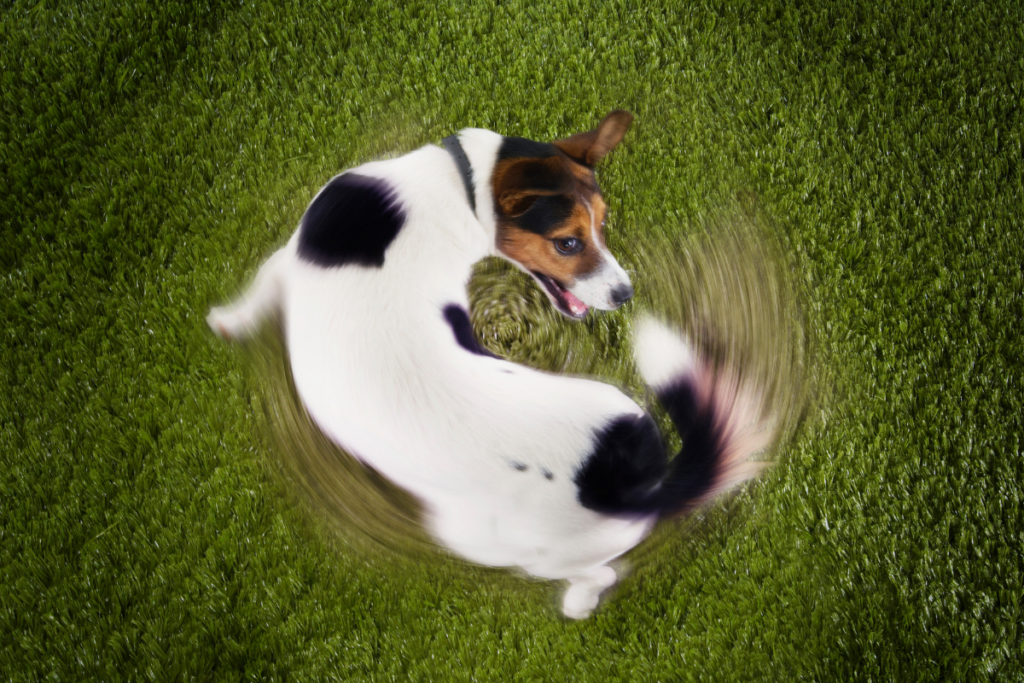
We’ve all seen videos on socials of tail chasing dogs and it may seem funny, but is it really?
Obsessive Compulsive Disorder
Tail chasing can be described a typical obsessive-compulsive disorder (OCD) in dogs. Compulsive means a repetitive, irresistible urge to perform a behaviour.
Other OCD behaviours include: spinning, pacing, fly snapping, barking, shadow or light chasing, excessive licking and toy fixation.
It is important to note that many dogs will display these behaviours but usually only in response to specific triggers. For example, licking when itchy or barking in response to a sound.
Potential causes
Tail chasing is suggested to have a genetic predisposition as it is more common in certain breeds, such as Bull Terriers, German Shepherds and Staffordshire Bull Terriers.
Physical conditions can also cause tail chasing such as: anal gland problems, wounds, skin infections or itchiness and parasites.
Other possible causes include;
- Anxiety/stress
- Boredom
- Social conflict (for example frequent aggression from another pet)
- Attention seeking
- Excitement
- Fear
- Puppies may often start tail chasing out of curiosity
First step = medical check
It is very important to seek veterinary advice if your pet starts chasing their tail. Underlying medical conditions such as skin irritations, parasites, bacterial or viral infections or head injuries, all need to be treated by a vet before any behavioural modification plan is put into place and can be effective.
Identify and remove/prevent triggers
Once a medical condition has been ruled out try to identify what may trigger the tail chasing, then remove or prevent this. For example, if your dog is triggered to tail chase when they are excited, try to interrupt or distract before your dog gets too excited.
If the trigger is something more complex such as stress or anxiety, you may need to discuss this with a Behaviour Vet, and in some cases, medication may be required.
Redirect attention
It’s important to redirect your dog’s attention away from their tail by interrupting tail chasing and redirecting your dog to do an incompatible behaviour such as sit, or target to hand. The more a dog practices the tail chasing, the more chance the behaviour has to become a true OCD behaviour and therefore much harder to change.
The use of punishment
Punishment in all forms from saying ‘no/ah ah’, to physical punishment such as hitting, will increase anxiety/stress and confuse the dog. In some cases, using punishment can even be reinforcing for attention seeking dogs. If the cause of tail chasing is attention seeking, any form of attention can be reinforcing.
Increase mental stimulation
For all types of OCD behaviours (and for all dogs in general), it is always beneficial to increase mental stimulation in the form of environmental enrichment. This will help to redirect attention away from tail chasing, providing the enrichment is suitable and interesting for your dog. Spend some time finding out what sort of food toys your dog likes, and how to make their meals times as interesting as possible.
Seek help
All potential OCD behaviours in dogs should be taken seriously. We encourage you to seek professional guidance as soon as you notice there may be a problem.
Further Reading
Tiira, K, et al (2012) Environmental Effects on Compulsive Tail Chasing in Dogs, National Center for Biotechnology Information (NCBI)[Internet]
Available from: https://www.ncbi.nlm.nih.gov/pmc/articles/PMC3406045/
